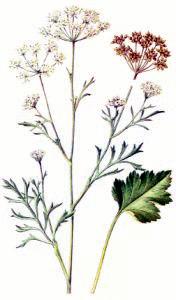Anise
| Pimpinella anisum | ||||||||||||||||
|---|---|---|---|---|---|---|---|---|---|---|---|---|---|---|---|---|
 | ||||||||||||||||
| Scientific classification | ||||||||||||||||
| ||||||||||||||||
| Binomial name | ||||||||||||||||
| Pimpinella anisum L. 1753 | ||||||||||||||||
| Synonyms | ||||||||||||||||
|
None |
Anise (Pimpinella anisum), also known as aniseed, anis, and sweet cumin, is an annual herbaceous plant in the Apiaceae family that produces oil-rich fruits that have a distinct licorice taste. Native to the Mediterranean and first cultivated in Egypt, anise is now produced in Mexico, the Middle East, Eastern Europe, Chile, Pakistan, and China. The aniseed can be used in cooking, potpourri, and herbal medicine.
Aniseed should not be confused with the similar tasting star anise or the seeds of fennel.
Anise leaves, although very delicate, can be used for garnishing, and for flavoring food; they do not cook well. Again, they should not be confused with chervil or fennel.
Description
Anise grows to between 18 and 24 inches in height with bright green feather-like leaves and blooms with small white clusters of flowers. The seeds are green-brown and oval in shape with rigid surfaces, measuring 2-4 millimeters. One plant will yield approximately two tablespoons of fruit.
Cultivation
Anise is grown from seed and should be planted in its permanent location, as it does not respond well to being transplanted. It is planted in the spring and takes about three months to flower. Anise is best suited for dry, well-drained soil in an area where it will receive full sun and remain frost-free for 120 days.
History
Anise is one of the oldest known cultivated herbs, originating in the Mediterranean, the Levant, and Egypt. Egyptians would place anise inside the body prior to mummification as an aromatic.[1] It is also mentioned in the New Testament.[2] Pliny the Elder wrote in the first century that the best anise was found in Crete and discussed some of it's medical benefits, as well as noting that Pythagoras favored it as an antidote for scorpion stings when placed in wine.[3] The Roman agricultural writer Palladius wrote about sowing cumin and anise in the fourth century.[4] As it spread in popularity throughout Europe, in 1305 King Edward I taxed the aniseed to help pay for repairs to London Bridge. There was also a popular belief that creating a potpourri or place anise under your pillow at night would ward off the "evil eye". [5]
Usage
Culinary
The fruit, frequently erroneously referred to as a seed, is used as flavor for numerous liquors around the world. Some notable examples of this are Greek ouzo, Spanish ojen, Turkish raki, and the French pastis brands, Pernod and Ricard. Prior to being banned in many parts of the world in the 1910's, the notorious absinthe usually counted anise among its flavorings.
Aniseed is commonly used as a flavoring in bread, cakes, cookies, and candies. It is also used flavor fish, poultry, soup, and stews. The leaves, which have a more subtle flavor, can be used in salads.
Medicinal
Chemicals within the anise fruit can provide several theraputic benefits. Anethole, the chemical compound that causes the licorice flavor of the fruit, can be used to settle an upset stomach and indigestion. Aniseed also contains the chemicals creosol and alpha-pinene, which function as expectorants, and dianethole and photoanethole, which behave similarly to estrogen.[6]
Other
Some fishermen use anise oil on their fishing lures to attract freshwater fish. [7]
References
- ↑ Long, George. The Egyptian Antiquities in the British Museum: Monuments, Obelisks, Temples, Sphinxes, Sculpture, Statues, Paintings, Pyramids, Mummies, Papyrus, and the Rosetta Stone, 1846, p. 146. Google Books link
- ↑ "Woe unto you, scribes and Pharisees, hypocrites! for ye pay tithe of mint and anise and cummin, and have omitted the weightier matters of the law, judgment, mercy, and faith: these ought ye to have done, and not to leave the other undone." Matthew 23:23, KJV.
- ↑ Gaius Plinius Secundus. The Natural History of Pliny. Trans. Bostock, John and Riley, H.T. 1890, pp. 271-272. Google books online
- ↑ Rutilius Taurus Aemilianus Palladius. On Husbondrie. Trans. Lodge, Barton and Herrtage, Sidney JH. 1879, p.86 Google books online
- ↑ Grieve, Maude. A Modern Herbal, online version
- ↑ Anise Information on Healthline.com. Retrieved on 2009-02-28.
- ↑ Oils, Aminos, Plants, Phermones and Mr. Steelhead by Mike Laverty and Luhr Jensen. Retrieved on 2009-03-01.